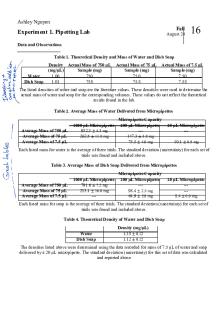Pipetting Selecting and Using Micropipettes Lab Manual (English) PDF

| Title | Pipetting Selecting and Using Micropipettes Lab Manual (English) |
|---|---|
| Author | Angel Enverga |
| Course | Biology |
| Institution | University of the Philippines System |
| Pages | 3 |
| File Size | 171.5 KB |
| File Type | |
| Total Downloads | 83 |
| Total Views | 143 |
Summary
Selecting and Using Micropipettes...
Description
Virtual Lab Manual Pipetting: Selecting and Using Micropipettes Synopsis Micropipettes are the extended arms of every aspiring scientist. In this simulation, you will be introduced to the basics of pipetting as you dive right into trying your new skill out in the lab. Step by step, you will learn how to adjust the volume on the P20, P200, and P1000 pipette, use the two ‘stops’ of the plunger and find out which pipette to use for which volume range. After learning the tricks of pipetting accurately in the microliter range, will you be able to select the correct micropipette when you are given the challenge to do so?
Try out the P1000 Micropipette After your introduction, you will be able to get hands-on experience with the P1000 micropipette, exploring all its parts and functions. While selecting the right pipette tip to P1000, you will also learn the importance of sterile work. You will get to explore the measuring range of a calibrated P1000 pipette by using the thumbwheel and practice aspirating and dispensing by adding a common buffer to a fresh microcentrifuge tube. Become a master of pipetting You will learn about the benefits of microscale experimentation to understand why micropipettes are essential instruments for laboratory work. In our virtual labs, we use airdisplacement pipettes that aspirate and dispense liquid samples. For the best pipetting technique, you will first learn about the two stops on the plunger, the measurement ranges of P20, P200, and P1000 pipettes, and interpret the volume display of micropipettes. This knowledge is essential if you want to accurately and precisely measure small volumes in a laboratory setting.
Select
the
correct
micropipette
Finally, you will be presented with a challenge to choose the correct micropipette for a 1
Copyright Labster ApS 2020 All Rights Reserved
hypothetical task. Will you be able to decide to use the P20, P200, or the P1000 micropipette for the most accurate pipetting?
Learning Objectives At the end of this simulation, you will be able to… ● Explain why micropipettes are used in laboratory settings ● Choose the correct pipettor for a given use case ● Describe to correct use of the two stops on a micropipette plunger
Techniques in Lab ● Pipetting
Theory Sterilization Sterilization refers to the removal of all microorganisms in a material or on an object. Sterilization ensures that even fungal spores or highly resistant bacterial endospores are killed. Sterilizing media The medium and its container must be sterilized by autoclaving before use, to avoid contamination. The autoclave utilizes high-pressure saturated steam at 121o C for 15 to 20 minutes to kill the microorganisms in the medium and its container. To ensure that the autoclave procedure has been conducted correctly, the bottle that contains the medium is labeled with a piece of autoclave tape. The autoclave tape has a white stripe which will turn black if subjected to high-temperature steam. Therefore, we can identify whether a bottle of the medium has been autoclaved/sterilized or not by looking at the stripe color of the autoclave tape.
2
Copyright Labster ApS 2020 All Rights Reserved
Figure 2: Autoclave tape. Before autoclave; white stripe, After autoclave: black stripe Sterilizing equipment Lab equipment can be sterilized by autoclaving, heating it up on a flame, or using disinfectants such as ethanol to kill germs. Microliter pipette Micropipettes come in different sizes. At Labster we use the following pipettes:
Figure 3 Micropipettes To adjust the volume, turn the adjustable wheel or the plunger (depending on the pipette) until the desired volume is displayed on the readout. It is very important to stay within the volume range of the respective pipette to avoid contaminating the pipette or producing inaccurate measurements. The proper pipetting technique is important to ensure an accurate volume of liquid is transferred.
3
Copyright Labster ApS 2020 All Rights Reserved...
Similar Free PDFs

Lab 1 - Use of Micropipettes
- 7 Pages

Lab 1 Manual - Using Vivado
- 10 Pages

OL Pipetting - OL Pipette LAb
- 3 Pages

teknik pipetting
- 3 Pages

Test manual UWES English
- 60 Pages

Intakt Manual english
- 74 Pages

CN-Lab-Manual - Full Lab Manual
- 34 Pages

Lab manual
- 49 Pages
Popular Institutions
- Tinajero National High School - Annex
- Politeknik Caltex Riau
- Yokohama City University
- SGT University
- University of Al-Qadisiyah
- Divine Word College of Vigan
- Techniek College Rotterdam
- Universidade de Santiago
- Universiti Teknologi MARA Cawangan Johor Kampus Pasir Gudang
- Poltekkes Kemenkes Yogyakarta
- Baguio City National High School
- Colegio san marcos
- preparatoria uno
- Centro de Bachillerato Tecnológico Industrial y de Servicios No. 107
- Dalian Maritime University
- Quang Trung Secondary School
- Colegio Tecnológico en Informática
- Corporación Regional de Educación Superior
- Grupo CEDVA
- Dar Al Uloom University
- Centro de Estudios Preuniversitarios de la Universidad Nacional de Ingeniería
- 上智大学
- Aakash International School, Nuna Majara
- San Felipe Neri Catholic School
- Kang Chiao International School - New Taipei City
- Misamis Occidental National High School
- Institución Educativa Escuela Normal Juan Ladrilleros
- Kolehiyo ng Pantukan
- Batanes State College
- Instituto Continental
- Sekolah Menengah Kejuruan Kesehatan Kaltara (Tarakan)
- Colegio de La Inmaculada Concepcion - Cebu







